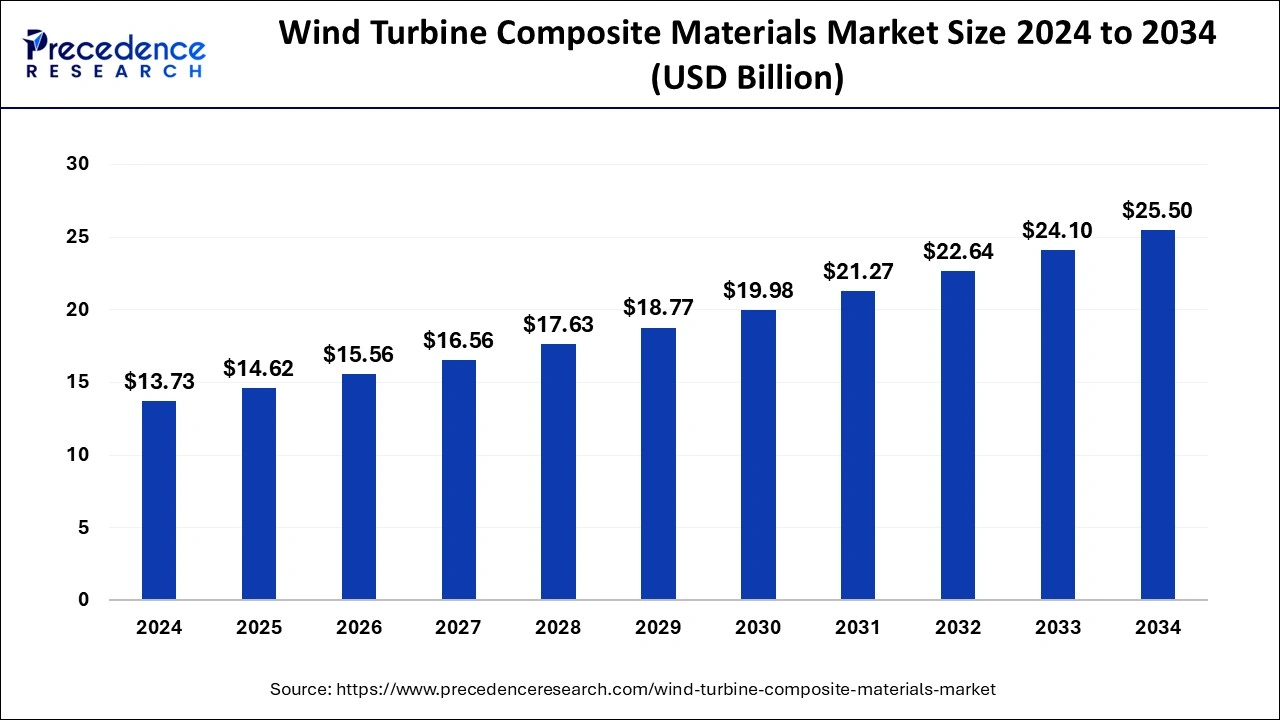The global wind turbine composite materials market size reached USD 12.90 billion in 2023 and is anticipated to attain around USD 24.10 billion by 2033, growing at a CAGR of 6.44% from 2024 to 2033.
Key Points
- Asia Pacific dominated the market in 2023 with the largest share 35%.
- North America is anticipated to grow at a notable growth rate in the wind turbine composite materials market during the forecast period.
- By fiber type, the glass fiber segment held the largest share of around 65% in 2023.
- By fiber type, the carbon fiber segment is expected to grow significantly during the forecast period.
- By technology, the vacuum injection molding segment accounted for the dominating share of 45% in 2023.
- By technology, the prepreg segment is observed to witness a considerable growth rate in the global wind turbine composite materials market over the forecast period.
- By application, the wind blades segment held the dominating share of 75% in 2023.

Wind turbine composite materials play a crucial role in the construction and operation of modern wind turbines. These materials are utilized extensively in various components of wind turbines due to their lightweight, durable, and corrosion-resistant properties. Composites are composite materials made from two or more constituent materials with significantly different physical or chemical properties that, when combined, produce a material with characteristics different from the individual components.
Get a Sample: https://www.precedenceresearch.com/sample/4067
Wind Turbine Composite Materials Market Scope
| Report Coverage | Details |
| Growth Rate from 2024 to 2033 | CAGR of 6.44% |
| Global Market Size in 2023 | USD 12.90 Billion |
| Global Market Size in 2024 | USD 13.73 Billion |
| Global Market Size by 2033 | USD 24.10 Billion |
| Largest Market | Asia-Pacific |
| Base Year | 2023 |
| Forecast Period | 2024 to 2033 |
| Segments Covered | By Fiber Type, By Technology, and By Application |
| Regions Covered | North America, Europe, Asia-Pacific, Latin America, and Middle East & Africa |
Wind Turbine Composite Materials Market Dynamics
One of the primary applications of composite materials in wind turbines is in the manufacturing of turbine blades. Turbine blades are subjected to high stress, fatigue, and environmental conditions during operation. Composite materials offer an ideal solution due to their high strength-to-weight ratio, which allows for the construction of longer and more efficient blades. Additionally, composites can be tailored to specific performance requirements, such as stiffness, flexibility, and aerodynamic efficiency, ensuring optimal turbine performance.
The most common composite materials used in wind turbine blades are fiberglass reinforced plastics (FRP) and carbon fiber reinforced plastics (CFRP). Fiberglass composites, composed of glass fibers embedded in a polymer matrix, are widely used in smaller and medium-sized wind turbines due to their cost-effectiveness and ease of manufacturing. On the other hand, carbon fiber composites, featuring carbon fibers embedded in a resin matrix, offer superior strength and stiffness, making them ideal for larger and more advanced turbine blades.
In addition to turbine blades, composite materials are also employed in other components of wind turbines, including nacelles, hubs, and towers. Nacelles, which house the turbine’s gearbox, generator, and other critical components, require materials that can withstand heavy loads and harsh operating conditions. Composites provide excellent structural integrity, corrosion resistance, and thermal insulation, ensuring the reliability and longevity of nacelle components.
Furthermore, composite materials are utilized in turbine hubs, which connect the blades to the rotor shaft, and towers, which support the entire turbine structure. These components must withstand extreme mechanical forces, fatigue, and environmental factors such as wind, rain, and temperature fluctuations. Composites offer significant advantages over traditional materials such as steel and concrete, including reduced weight, improved fatigue resistance, and ease of transportation and installation.
The widespread adoption of composite materials in wind turbines has contributed to the growth and advancement of the wind energy industry. By enabling the construction of larger, more efficient, and more reliable wind turbines, composites have played a pivotal role in driving down the cost of wind energy production and increasing its competitiveness with conventional energy sources. Moreover, ongoing research and development efforts aim to further enhance the performance and durability of composite materials, paving the way for even more efficient and sustainable wind power generation in the future.
Read Also: Data Center Transformation Market Size, Share, Report by 2033
Recent Developments
- According to a BSE filing, in June 2023, SJVN Green Energy, a subsidiary of SJVN Ltd, secured a 200 MW wind power project through a tariff-based competitive bidding process conducted by the Solar Energy Corporation of India. This project requires an investment of Rs 1,400 crore. SJVN Green Energy will undertake the development of this wind power project anywhere in India through an EPC (engineering procurement construction) contract.
- Amazon now has more than 500 wind and solar projects globally, and once operational, they are expected to generate more than 77,000 gigawatt-hours (GWh) of clean energy each year, or enough to power 7.2 million U.S. homes.
Wind Turbine Composite Materials Market Companies
- TPI Composites Inc.
- Huntsman International LLC
- Teijin Limited
- TPI Composites Inc.
- LM Wind Power
- Suzlon Energy Limited
- Gurmit Holding AG
- LM Wind Power
- Molded Fiber Glass Companies
- Toray Industries, Inc.
- Vestas Wind Systems A/S
- Siemens Gamesa Renewable Energy, S.A.U.
- Hexcel Corporation
- Lianyungang Zhongfu Lianzhong Composites Group Co. Ltd
- Others
Segments Covered in the Report:
By Fiber Type
- Glass Fiber
- Carbon Fiber
- Others
By Technology
- Vacuum Injection Molding
- Prepreg
- Hand Lay-Up
- Others
By Application
- Wind blades
- Nacelles
- Others
By Geography
- North America
- Europe
- Asia-Pacific
- Latin America
- Middle East and Africa
Contact Us:
Mr. Alex
Sales Manager
Call: +1 9197 992 333
Email: sales@precedenceresearch.com
Web: https://www.precedenceresearch.com
Blog: https://www.expresswebwire.com/
Blog: https://www.uswebwire.com/
Blog: https://www.dailytechbulletin.com/
